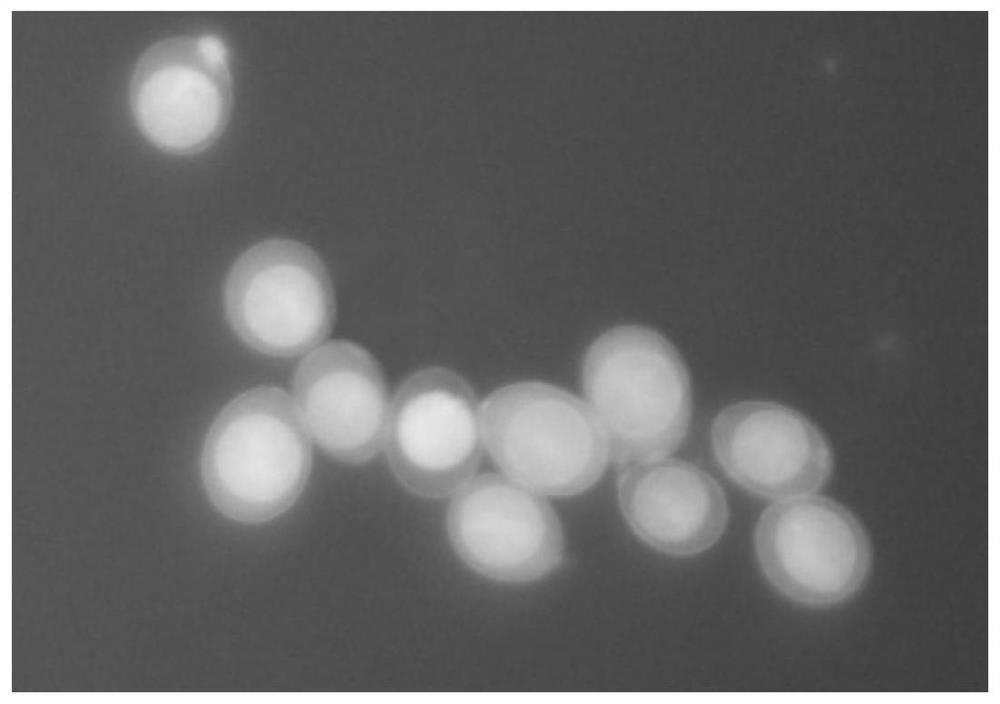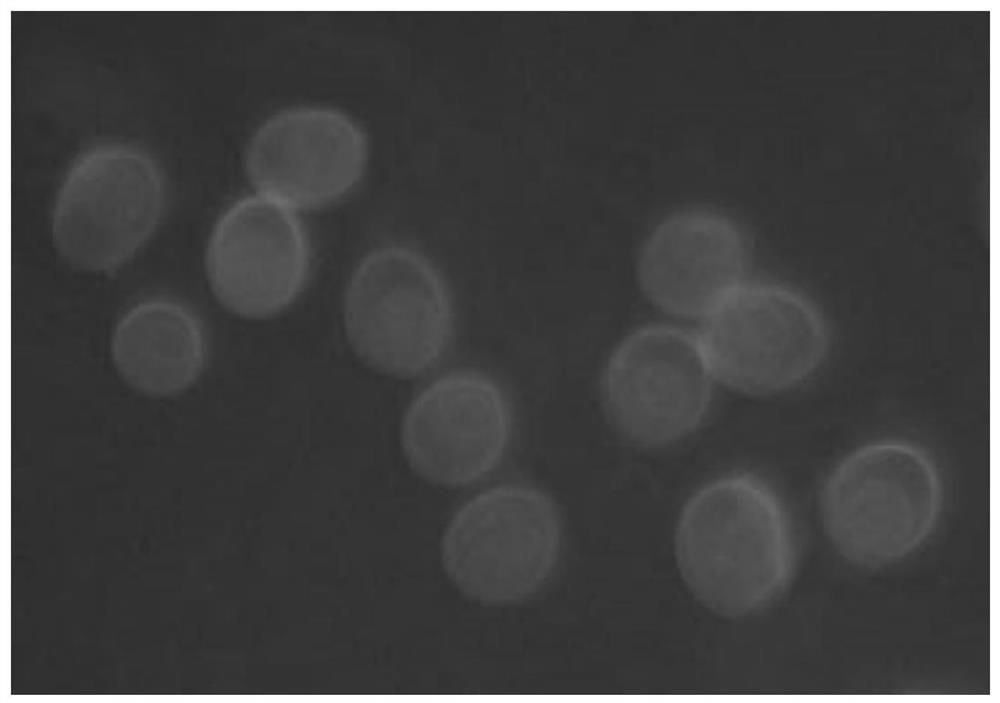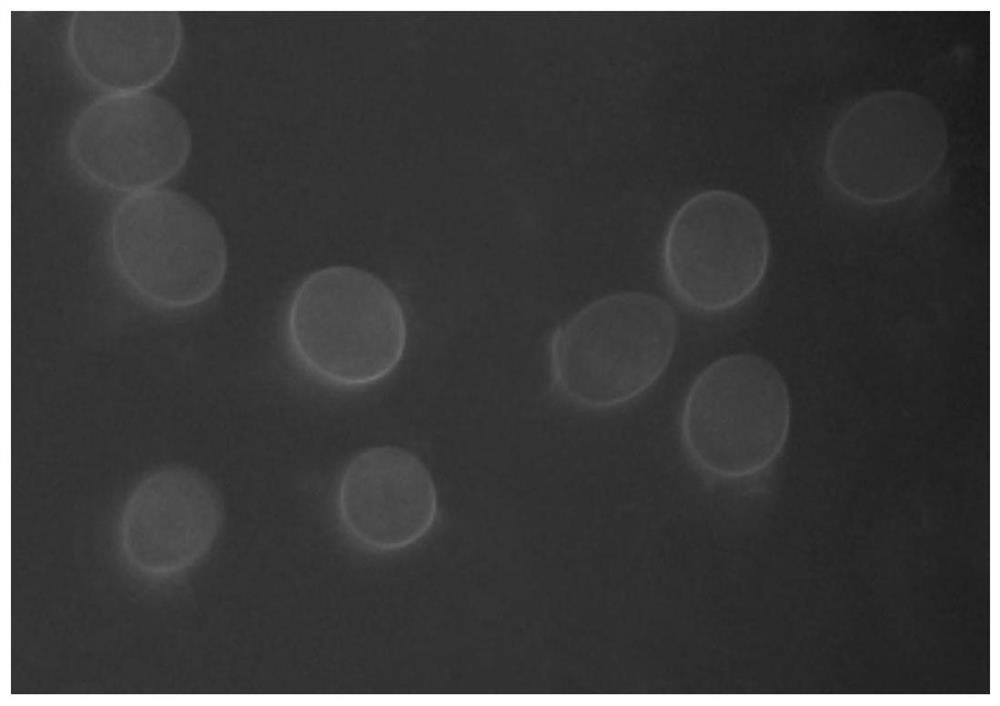A kind of staining method of Eimeria tenella protoplasts
A technology of Eimeria cocci and protoplasts, which is applied in the preparation of test samples and other directions, can solve the problem of not being able to retain the complete shape of the immature E. believable effect
- Summary
- Abstract
- Description
- Claims
- Application Information
AI Technical Summary
Problems solved by technology
Method used
Image
Examples
Embodiment 1
[0032] (1) Take the fresh immature Eimeria tenella oocysts isolated from the cecum after coccidial infection of chickens, use 20% sodium hypochlorite solution, 4 ℃ refrigerator for 10min, and use sterilized water for centrifugal washing 3 times to remove sodium hypochlorite . Add 1.1mol / L sucrose solution to the last sediment, centrifuge at 2000rpm for 10min, float the oocysts, suck the oocysts into another centrifuge tube, and wash with sterilized water 3 times to remove the sucrose.
[0033] (2) placing the purified immature Eimeria tenella oocysts at 4°C and -20°C for 15 minutes, and freeze-thaw cycles three times;
[0034] (3) 37% concentrated hydrochloric acid-95% ethanol aqueous solution (volume ratio of 1:1) was used to treat the immature Eimeria tenella oocysts after freeze-thaw cycles. solution, washed three times with distilled water, and adjusted the concentration of oocysts to 1 × 10 3 pcs / μl;
[0035] (4) Hoechst 33258 dye was added to the Eppendorf tube contai...
Embodiment 2
[0038] (1) Take the fresh immature Eimeria tenella oocysts isolated from the cecum after coccidial infection of chickens, use 20% sodium hypochlorite solution, 4 ℃ refrigerator for 10min, and use sterilized water for centrifugal washing 3 times to remove sodium hypochlorite . Add 1.1mol / L sucrose solution to the last sediment, centrifuge at 2000rpm for 10min, float the oocysts, suck the oocysts into another centrifuge tube, and wash with sterilized water 3 times to remove the sucrose.
[0039] (2) placing the purified immature Eimeria tenella oocysts at 4°C and -20°C for 14 minutes, and freeze-thaw cycles three times;
[0040] (3) 36% concentrated hydrochloric acid-93% ethanol aqueous solution (volume ratio of 1:0.5) was used to treat the immature Eimeria tenella oocysts after freeze-thaw cycles. solution, washed three times with distilled water, and adjusted the concentration of oocysts to 1 × 10 3 pcs / μl;
[0041] (4) Add Hoechst 33258 dye to the Eppendorf tube containing...
Embodiment 3
[0044] (1) Take the fresh immature Eimeria tenella oocysts isolated from the cecum after coccidial infection of chickens, use 20% sodium hypochlorite solution, 4°C refrigerator for 10min, and use sterilized water for centrifugal washing 3 times to remove sodium hypochlorite . Add 1.1mol / L sucrose solution to the last sediment, centrifuge at 2000rpm for 10min, float the oocysts, suck the oocysts into another centrifuge tube, and wash with sterilized water 3 times to remove the sucrose.
[0045] (2) placing the purified immature Eimeria tenella oocysts at 4°C and -20°C for 16 min, and freeze-thaw cycles three times;
[0046] (3) 38% concentrated hydrochloric acid-97% ethanol aqueous solution (volume ratio of 1:1.5) was used to treat immature Eimeria tenella oocysts after freeze-thaw cycles. solution, washed three times with distilled water, and adjusted the concentration of oocysts to 1 × 10 3 pcs / μl;
[0047] (4) Hoechst 33258 dye was added to the Eppendorf tube containing t...
PUM
 Login to View More
Login to View More Abstract
Description
Claims
Application Information
 Login to View More
Login to View More - R&D
- Intellectual Property
- Life Sciences
- Materials
- Tech Scout
- Unparalleled Data Quality
- Higher Quality Content
- 60% Fewer Hallucinations
Browse by: Latest US Patents, China's latest patents, Technical Efficacy Thesaurus, Application Domain, Technology Topic, Popular Technical Reports.
© 2025 PatSnap. All rights reserved.Legal|Privacy policy|Modern Slavery Act Transparency Statement|Sitemap|About US| Contact US: help@patsnap.com



